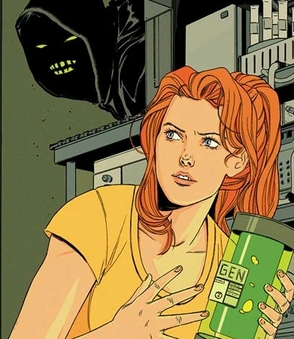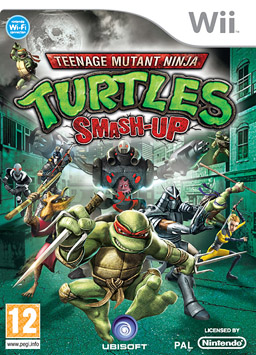A fighting game is a genre of video game that involves combat between two or more characters. Fighting game combat often features mechanics such as blocking, grappling, counter-attacking, and chaining attacks together into "combos". Characters generally engage in battle using hand-to-hand combat—often some form of martial arts. The fighting game genre is related to, but distinct from, the beat 'em up genre, which pits large numbers of computer-controlled enemies against one or more player characters.
An action game is a video game genre that emphasizes physical challenges, including hand–eye coordination and reaction time. The genre includes a large variety of sub-genres, such as fighting games, beat 'em ups, shooter games, rhythm games and platform games. Multiplayer online battle arena and some real-time strategy games are also considered action games.

April O'Neil is a fictional character from the Teenage Mutant Ninja Turtles comics. She is the first human ally of the Ninja Turtles.
Super Smash Bros. is a crossover platform fighting game series published by Nintendo. The series was created by Masahiro Sakurai, who has directed every game in the series. The series is known for its unique gameplay objective which differs from that of traditional fighters, in that the aim is to increase damage counters and knock opponents off the stage instead of depleting life bars.

Teenage Mutant Ninja Turtles: Tournament Fighters, or Teenage Mutant Hero Turtles: Tournament Fighters in Europe, is the title of three different fighting games based on the Teenage Mutant Ninja Turtles, produced by Konami for the Nintendo Entertainment System, Sega Genesis, and Super NES and released during a period between 1993 and 1994. Konami produced a different fighting game based on the franchise each featuring a differing cast of characters for the platforms. All three versions of the game were re-released as part of Teenage Mutant Ninja Turtles: The Cowabunga Collection in 2022. with online play using rollback netcode for the SNES version of the game.
A beat 'em up is a video game genre featuring hand-to-hand combat against a large number of opponents. Traditional beat 'em ups take place in scrolling, two-dimensional (2D) levels, while a number of modern games feature more open three-dimensional (3D) environments with yet larger numbers of enemies. The gameplay tends to follow arcade genre conventions, such as being simple to learn but difficult to master, and the combat system tends to be more highly developed than other side-scrolling action games. Two-player cooperative gameplay and multiple player characters are also hallmarks of the genre. Most of these games take place in urban settings and feature crime-fighting and revenge-based plots, though some games may employ historical, science fiction or fantasy themes.

Digimon Rumble Arena is a 2001 fighting video game developed and published by Bandai. It is part of a video game series connected to the Digimon franchise and showcases the titular creatures within the context of a fighting video game. The player controls one of several Digimon and engages in combat with other Digimon within a variety of settings. Apart from the central fighting gameplay, a trio of mini-games are available upon the single-player campaign's completion.

Digimon Rumble Arena 2, known as Digimon Battle Chronicle in Japan, is a 2004 Digimon fighting video game, released by Bandai for the PlayStation 2, GameCube, and the Xbox. It is the sequel to 2001's Digimon Rumble Arena and has a similar style of gameplay as Super Smash Bros. Melee, except with a health meter. Digimon All-Star Rumble, a spiritual successor to the Rumble Arena games, was later released in 2014.

Super Smash Bros. Brawl is a 2008 crossover fighting game developed by Sora Ltd. and Game Arts and published by Nintendo for the Wii. The third installment in the Super Smash Bros. series, it was announced at a pre-E3 2005 press conference by Nintendo president Satoru Iwata. Masahiro Sakurai, director of the previous two games in the series, assumed the role of director at Iwata's request. Game development began in October 2005 with a creative team that included members from several Nintendo and third-party development teams. After delays due to development problems, the game was released worldwide in 2008.

Teenage Mutant Ninja Turtles: Smash-Up is a 2.5D fighting game for the Wii and PlayStation 2 video game consoles featuring characters from the Teenage Mutant Ninja Turtles franchise. It was developed by Game Arts in cooperation with Mirage Studios, and released by Ubisoft in September 2009 in celebration of the TMNT franchise's 25th anniversary.
Teenage Mutant Ninja Turtles is an American animated television series developed by Ciro Nieli, Joshua Sternin, and Jennifer Ventimilia for Nickelodeon, based on the characters created by Kevin Eastman and Peter Laird. The series begins with the Turtles emerging from their sewer home for the first time, using their ninjutsu training to fight enemies in present-day New York City. The series ran in the United States from September 28, 2012, to November 12, 2017.

Super Smash Flash is a series of fighting browser games published by McLeodGaming, led by Gregory McLeod under the alias Cleod9. It is based on the Super Smash Bros series. The original Super Smash Flash is based specifically on Super Smash Bros. Melee. Its follow-up, also considered a reboot, is Super Smash Flash 2. The developer is currently working on an original crossover fighting game, Fraymakers.

Project M is a mod of the 2008 fighting game Super Smash Bros. Brawl for the Wii, created by the community group known as the Project M Development Team. It is designed to retool Brawl to play more like its two predecessors, Super Smash Bros. (1999) and Super Smash Bros. Melee (2001), in response to fan objections to Brawl's physics, slower-paced gameplay, larger use of chance elements, and mechanics of certain attacks. Project M reintroduces Dr. Mario, Mewtwo, and Roy, who were present in Melee but were cut from Brawl due to time constraints. In addition, it features a new art style for in-game menus and allows players to choose certain characters individually when they are only accessible as transformations of other ones in Brawl.

Super Smash Land is a fan-made demake of Super Smash Bros. released on September 14, 2011, by Dan Fornace. The game features six playable characters and 11 stages. The game's visual design resembles the graphics for the Game Boy and was developed with GameMaker 7.

Rivals of Aether is a platform fighter game created by Dan Fornace, and released for Microsoft Windows in March 2017, for Xbox One in August 2017, and for Nintendo Switch in September 2020. It received positive reception from critics, who commended its deep gameplay.

Super Smash Con is an annual Super Smash Bros. convention and tournament series held at the Dulles Expo Center in Chantilly, Virginia. The event is held in early August and focuses on the video game series published by Nintendo along with other video games, and features tournaments for every entry in the series. Side events have featured other platform fighters, including Rivals of Aether, Slap City, and Nickelodeon All-Star Brawl.

Nickelodeon All-Star Brawl is a 2021 crossover fighting game developed by Ludosity and Fair Play Labs, and published by GameMill Entertainment. It is part of the Nickelodeon Super Brawl series of browser games and mobile games, serving as its first console game. Featuring characters from various Nickelodeon animated television series, the game was released on October 5, 2021, for Nintendo Switch, PlayStation 4, PlayStation 5, Windows, Xbox One, and Xbox Series X/S. A sequel, Nickelodeon All-Star Brawl 2, released in 2023.

Nickelodeon Super Brawl, or simply Nickelodeon Brawl, is a series of crossover fighting video games, featuring characters from various Nickelodeon animated television series. According to the team at Nick Games, the series follows the play style of "popular fighting games like Mortal Kombat, Super Smash Bros., Street Fighter, and Tekken, but with a comical twist."

Nickelodeon All-Star Brawl 2 is a 2023 crossover fighting game developed by Fair Play Labs and published by GameMill Entertainment. It is the sequel to Nickelodeon All-Star Brawl (2021) and part of the Nickelodeon Super Brawl series. The game was released on November 7, 2023, for Nintendo Switch, PlayStation 4, PlayStation 5, Windows, Xbox One, and Xbox Series X/S.














